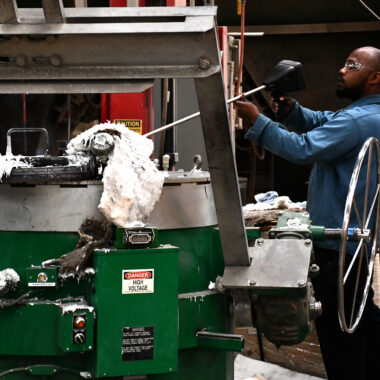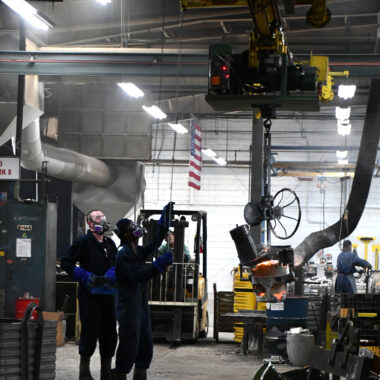Dive Deep: Insights About Aluminum Casting Processes
Dive Deep: Insights About Aluminum Casting Processes
Blog Article
Crafting Perfection: Exactly How to Achieve High-Quality Light Weight Aluminum Castings Each Time
In the realm of light weight aluminum spreading, the pursuit of perfection is a continuous journey that requires a meticulous approach and a keen understanding of the intricacies included. Attaining consistent high-grade light weight aluminum spreadings demands an extensive grasp of the procedures, from selecting the ideal alloy to executing accurate mold designs and thoroughly managing spreading criteria. Nevertheless, the real proficiency depends on the capability to carry out these elements perfectly to develop flawless spreadings every time. As we check out the intricacies of crafting excellence in aluminum castings, discovering the crucial approaches and techniques that result in impressive results becomes critical for those making every effort for quality in this specific field.
Comprehending Aluminum Casting Procedures
Aluminum casting processes, crucial in the manufacturing industry, entail the intricate makeover of molten light weight aluminum right into strong types with a collection of thoroughly regulated actions. Understanding these processes is vital to attaining top notch aluminum spreadings consistently - about aluminum casting. The main methods made use of in aluminum casting are die casting, sand spreading, and investment casting

Each of these procedures has its advantages and is selected based upon variables like complexity, quantity, and desired surface of the light weight aluminum spreading. about aluminum casting. Understanding the ins and outs of these techniques is important for suppliers intending to produce premium aluminum spreadings constantly
Choosing the Right Light Weight Aluminum Alloy
Picking the proper light weight aluminum alloy is a critical decision in the production of high-quality aluminum spreadings. The choice of alloy considerably influences the homes and characteristics of the end product. Various aluminum alloys offer differing degrees of toughness, rust resistance, machinability, and thermal conductivity. When selecting an aluminum alloy for spreading, it is necessary to think about the certain requirements of the application to make certain ideal efficiency.
One of the most frequently used aluminum alloys for spreading is A356. This alloy uses excellent castability, high strength, and good corrosion resistance, making it ideal for a vast array of applications. 6061 light weight aluminum alloy is favored for its exceptional weldability and good mechanical residential or commercial properties. For applications requiring high toughness, 7075 aluminum alloy is a prominent selection due to its phenomenal strength-to-weight proportion.
Along with mechanical properties, considerations such as cost, availability, and post-casting processes must also influence the selection of the best aluminum alloy. By carefully assessing these aspects, makers can make sure the manufacturing of premium aluminum castings that fulfill the wanted specifications.
Implementing Proper Mold And Mildew Style
Developing an efficient mold and mildew style is important for making certain the effective manufacturing of top notch aluminum castings. Appropriate mold design plays a substantial function in accomplishing the desired qualities of the last item. To implement a successful mold and mildew style, variables such as material circulation, cooling rates, and component geometry should be thoroughly considered.
One secret aspect of mold design is ensuring correct dental filling and solidification of the light weight aluminum within the mold dental caries. This entails developing runner and gating systems that promote smooth metal flow and avoid defects such as air entrapment or incomplete filling. In addition, including cooling networks into the mold layout assists regulate solidification prices and minimize the threat of porosity or shrinking defects.

Controlling Spreading Parameters

Making Sure Post-Casting Quality Checks
To maintain the high top quality of aluminum castings, complete post-casting high quality checks are vital. After the spreading procedure is completed, it is essential to make certain that the end products satisfy the wanted standards and specifications. One of the main top quality checks includes checking the surface finish of the spreadings to recognize any flaws such as porosity, splits, or surface abnormalities. This aesthetic inspection is usually supplemented by non-destructive screening techniques like ultrasonic testing or color penetrant assessment to spot inner problems that may compromise the integrity of the casting.
Dimensional accuracy is another vital aspect that should be verified during post-casting high quality checks. Dimensions of vital measurements and resistances ought to be required to verify that the spreadings adapt the called for specs. Furthermore, mechanical residential or commercial properties such as firmness, tensile toughness, and effect resistance might require to be examined with material screening to make sure that the spreadings have the essential toughness and toughness for their desired application.
Final Thought
Finally, attaining premium light weight aluminum castings requires an extensive understanding of the casting processes, choosing the suitable alloy, creating mold and mildews efficiently, managing casting specifications diligently, and conducting post-casting quality checks faithfully. By following these actions, manufacturers can continually create light weight aluminum castings that meet the highest criteria of top quality and efficiency.
Achieving regular top notch light weight aluminum castings requires a thorough understanding of the processes, from choosing the proper alloy to implementing precise mold designs and diligently managing spreading specifications. The primary techniques used in light weight aluminum casting are die spreading, sand spreading, and financial investment spreading.
Financial investment casting, likewise recognized as accuracy spreading, involves producing wax patterns that are covered look at this now in ceramic to develop mold and mildews.Selecting the suitable aluminum alloy is an essential choice in i was reading this the manufacturing of premium light weight aluminum castings.Ensuring precise control over spreading parameters is crucial for preserving consistency and high quality in aluminum spreading manufacturing.
Report this page